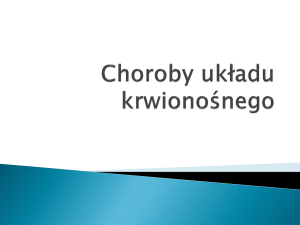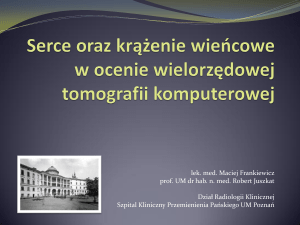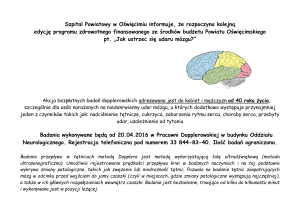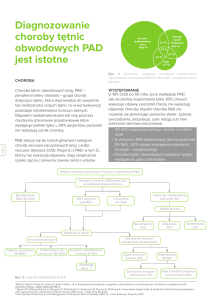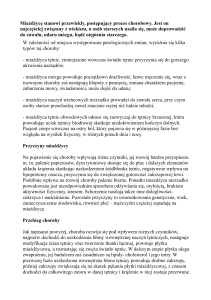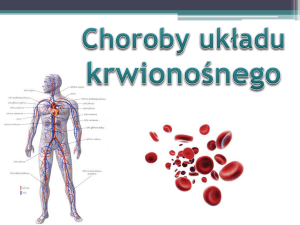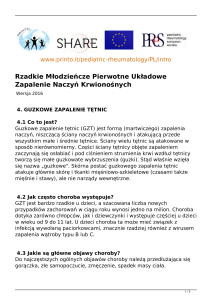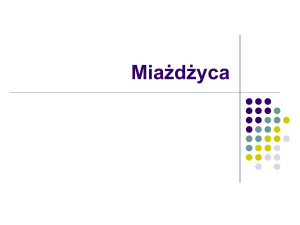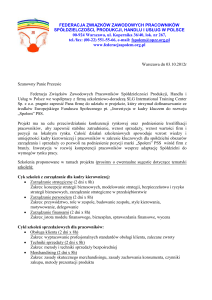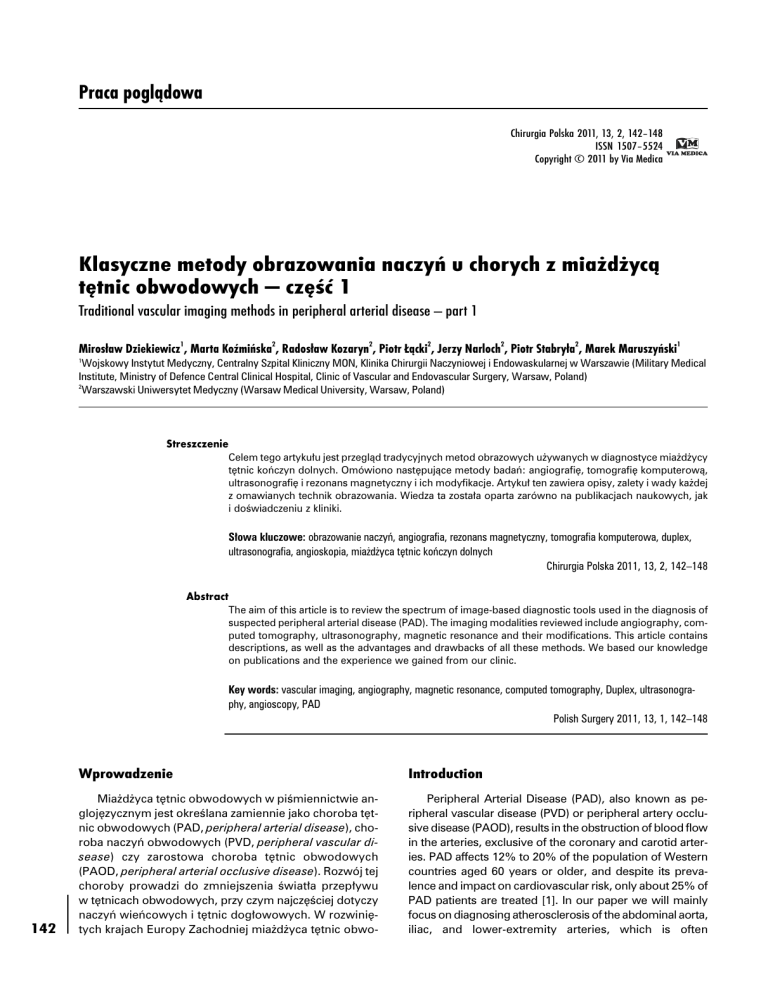
Praca poglądowa
Chirurgia Polska 2011, 13, 2, 142–148
ISSN 1507–5524
Copyright © 2011 by Via Medica
Klasyczne metody obrazowania naczyń u chorych z miażdżycą
tętnic obwodowych — część 1
Traditional vascular imaging methods in peripheral arterial disease — part 1
Mirosław Dziekiewicz1, Marta Koźmińska2, Radosław Kozaryn2, Piotr Łącki2, Jerzy Narloch2, Piotr Stabryła2, Marek Maruszyński1
1
Wojskowy Instytut Medyczny, Centralny Szpital Kliniczny MON, Klinika Chirurgii Naczyniowej i Endowaskularnej w Warszawie (Military Medical
Institute, Ministry of Defence Central Clinical Hospital, Clinic of Vascular and Endovascular Surgery, Warsaw, Poland)
2
Warszawski Uniwersytet Medyczny (Warsaw Medical University, Warsaw, Poland)
Streszczenie
Celem tego artykułu jest przegląd tradycyjnych metod obrazowych używanych w diagnostyce miażdżycy
tętnic kończyn dolnych. Omówiono następujące metody badań: angiografię, tomografię komputerową,
ultrasonografię i rezonans magnetyczny i ich modyfikacje. Artykuł ten zawiera opisy, zalety i wady każdej
z omawianych technik obrazowania. Wiedza ta została oparta zarówno na publikacjach naukowych, jak
i doświadczeniu z kliniki.
Słowa kluczowe: obrazowanie naczyń, angiografia, rezonans magnetyczny, tomografia komputerowa, duplex,
ultrasonografia, angioskopia, miażdżyca tętnic kończyn dolnych
Chirurgia Polska 2011, 13, 2, 142–148
Abstract
The aim of this article is to review the spectrum of image-based diagnostic tools used in the diagnosis of
suspected peripheral arterial disease (PAD). The imaging modalities reviewed include angiography, computed tomography, ultrasonography, magnetic resonance and their modifications. This article contains
descriptions, as well as the advantages and drawbacks of all these methods. We based our knowledge
on publications and the experience we gained from our clinic.
Key words: vascular imaging, angiography, magnetic resonance, computed tomography, Duplex, ultrasonography, angioscopy, PAD
Polish Surgery 2011, 13, 1, 142–148
142
Wprowadzenie
Introduction
Miażdżyca tętnic obwodowych w piśmiennictwie anglojęzycznym jest określana zamiennie jako choroba tętnic obwodowych (PAD, peripheral arterial disease), choroba naczyń obwodowych (PVD, peripheral vascular disease) czy zarostowa choroba tętnic obwodowych
(PAOD, peripheral arterial occlusive disease). Rozwój tej
choroby prowadzi do zmniejszenia światła przepływu
w tętnicach obwodowych, przy czym najczęściej dotyczy
naczyń wieńcowych i tętnic dogłowowych. W rozwiniętych krajach Europy Zachodniej miażdżyca tętnic obwo-
Peripheral Arterial Disease (PAD), also known as peripheral vascular disease (PVD) or peripheral artery occlusive disease (PAOD), results in the obstruction of blood flow
in the arteries, exclusive of the coronary and carotid arteries. PAD affects 12% to 20% of the population of Western
countries aged 60 years or older, and despite its prevalence and impact on cardiovascular risk, only about 25% of
PAD patients are treated [1]. In our paper we will mainly
focus on diagnosing atherosclerosis of the abdominal aorta,
iliac, and lower-extremity arteries, which is often
Mirosław Dziekiewicz i wsp.
Klasyczne badania naczyniowe
Chirurgia Polska 2011, 13, 2
dowych występuje u 12–20% populacji chorych powyżej 60 rż. Mimo podwyższonego ryzyka wystąpienia
w tej grupie chorób sercowo-naczyniowych, tylko około
25% chorych poddaje się leczeniu [1]. W pracy przedstawiono tradycyjne metody badań naczyniowych wykorzystywane do obrazowania zmian miażdżycowych
w aorcie, tętnicach biodrowych, udowych i goleni. Szczególnie miażdżyca tętnic obwodowych zasługuje na uwagę ze względu na jej względne niedodiagnozowanie, niedocenianie tego problemu w środowisku medycznym
oraz w efekcie nieleczenie. Nie wolno jednak zapominać,
że badania obrazowe są badaniami uzupełniającymi
u tych chorych. Wciąż najważniejsze są badanie przedmiotowe i objawy kliniczne chorego, w tym ocena dystansu
chromania będącego wyrazem stopnia niedokrwienia
mięśni kończyn dolnych [2]. Nadal wskaźnik kostka ramię (ABI, ankle brachial index) jest skutecznym testem
przesiewowym u tych chorych [3]. Wyniki badań obrazowych są pomocne w ocenie anatomii naczyń, stopnia
zaawansowania zmian miażdżycowych, przepływu krwi
— szczególnie przed planowaną rewaskularyzacją. Poniżej przedstawiono charakterystyki najczęściej stosowanych tradycyjnych metod obrazowania tętnic.
Angiografia (arteriografia)
Komputerowa arteriografia subtrakcyjna (DSA, digital subtraction arteriography) jest nadal uznawana jako
złoty standard w ocenie tętnic kończyn dolnych oraz patologii dotyczących tych naczyń. Opis morfologii naczyń
w rentgenowskiej angiografii wydaje się bardzo dobrym
rozwiązaniem, pozwalającym na ocenę naczyń oraz obszarów deficytu ukrwienia. Oprócz subtrakcji pospolicie
używanymi technikami są także remaskowanie, przesuwalne i uzupełnione piksele oraz szybki i prosty widok.
Obrazowanie DSA stało się bardziej dostępne dla chirurgów dzięki skonstruowaniu mniejszych aparatów pozwalających na ich montaż jako dodatkowego wyposażenia
na sali operacyjnej [4]. Komputerowa arteriografia subtrakcyjna została również udoskonalona dla obrazowania zmian zachodzących w tętnicach w przebiegu cukrzycy dzięki możliwości wizualizacji dystalnych małych naczyń, które do tej pory, przez słabe wysycenie kontrastem, nie pozwalały się uwidocznić w wyżej wymienionym badaniu w stopniu zadowalającym.
Mimo powszechnego wdrożenia tej metody posiada
ona także ograniczenia. Głównymi wadami DSA są komplikacje związane z dostępem do naczyń oraz podaniem
kontrastu. Główne powikłania pojawiające się podczas
DSA lub po niej to: zawroty głowy, wymioty oraz reakcje
alergiczne ogólne lub miejscowe. Można obniżyć ryzyko
reakcji alergicznych u tych pacjentów, podając doustnie
metyloprednizolon p.o. przed angiografią [5]. To, czego
obawiamy się najbardziej, to nefrotoksyczność, która
może powodować nefropatię spowodowaną kontrastem
(CIN, contrast-induced nephropathy). Jest to nierzadka
przyczyna ostrej niewydolności nerek. W klasycznej arteriografii otrzymuje się obraz dwuwymiarowy, który jest
tylko odzwierciedleniem światła przepływu przez tętnicę
underdiagnosed, undertreated, and poorly understood by
the medical community. We also have to remember that
imaging methods are only additional to an accurate medical history in which intermittent claudication, defined as pain
in the muscles of the leg with ambulation, is the earliest
and the most frequent presented symptom in patients with
lower extremity PAD [2]. Even today, the simplest method
is the ankle brachial index (ABI) which is an excellent screening test for the presence of PAD [3]. Imaging studies just
provide us with additional anatomical information and help
one to assess the exact and current blood flow, mainly before revascularization. A variety of the most important methods known for several years is discussed below.
Angiography
Digital Subtraction Arteriography (DSA) is still used as
the gold standard for assessing the lower limbs arterial
vessels and the pathology of these vessels. Moreover, the
depiction of vessel morphology in X-ray angiography seems
to be very good solution allowing for the assessment of
vascular and perfusion deficit areas. DSA imaging has become more accessible to surgeons due to construction of
smaller cameras, enabling them to be installed as optional
equipment in the operating room [4]. Besides subtraction,
the commonly used techniques are re-masking, pixel shifting and stacking, or fast and simple view tracing. In addition, DSA has been specially enhanced for imaging changes
in the arteries during the course of diabetes through the
visualization of small distal vessels, which so far have been
unable to be displayed in the above test to a satisfactory
level due to the weak saturation of the contrast.
Despite incorporation of this method into every day
medical practice it has its own limitations. The main complications occurring during or after the DSA are as follows:
dizziness, vomiting and general or local allergic reactions.
We can reduce the risk of allergic reaction in patients with
severe allergy history reactions by oral premedication with
methlyprednisolone before an angiography [5]. However,
what we are most afraid of is nephrotoxicity, which can
result in contrast-induced nephropathy (CIN) which is
a common cause of acute renal failure in hospitalized patients.
In a standard arteriography we get a two-dimensional picture, which is only a reflection of the lumen flow through
the artery (called a lumenography). However, only indirect
conclusions can be reached about artherosclerotic plaques,
ulcers, para-arterial thrombosis etc. Despite its limitations,
angiography is a very valuable imaging method because
of the possibility of using it for endovascular treatment.
Thus, from having been a diagnostic procedure, this test
has evolved to the level of a tool used during real time
endovascular procedures. Nowadays, we perform
endovascular procedures including not only a percutaneous angioplasty, but also for the implantation of stents, stent
grafts, vascular malformation obliteration, nutritional tumor
vasculature obliteration, liver tumor radioembolization with
Yttrium-90 microspheres (called SIRT — Selective Internal
Radiation Therapy), the closure of leaks between the cavities of the heart and the implantation of endovascular aor-
143
Mirosław Dziekiewicz et al.
Traditional vascular imaging methods
(lumenography). Pośrednio można wnioskować zarówno o powierzchni blaszki miażdżycowej, jak i jej owrzodzeniech, skrzeplinach przyściennych itp. Jednak mimo
swoich ograniczeń badanie to jest bardzo cenne ze względu na możliwość wykorzystania go do zabiegów wewnątrznaczyniowych. Stąd od procedury diagnostycznej
badanie to ewoluowało do rangi narzędzia wykorzystywanego podczas zabiegów wewnątrznaczyniowych.
Obecnie wykonywane zabiegi wewnątrznaczyniowe obejmują nie tylko plastyki przezskórne, ale również na przykład implantacje stentów, stentgraftów, obliterację malformacji naczyniowych i naczyń odżywczych guzów nowotworowych, radioembolizację guzów wątroby z użyciem mikrosfer zawierających Itr90 (SIRT, selective internal radiation therapy), zamykanie ubytków między jamami serca oraz implantację wewnątrznaczyniową zastawki aortalnej (TAVI, transluminal aortic valve implantation).
Inna grupa zabiegów to trombectomie, trombendarektomie czy fibrynoliza celowana. Lista wykonywanych
z tego dostępu zabiegów wewnątrznaczyniowych stale
się wydłuża, a tym samym przydatność omawianej techniki diagnostycznej rośnie [6].
Angiografia w tomografii komputerowej
144
Wielodetektorowa tomografia komputerowa (MDCT,
Multi-Detection-row Computed Tomography), wprowadzona w 1998 roku (4-MDCT) szeroko rozpowszechniła
się na świecie i jest dzisiaj jedną z najpopularniejszych
oraz najlepiej dostępnych metod do diagnozy PAD. Daje
nam ona trzy fundamentalne udogodnienia do obrazowania naczyń: szybkość, odległość i grubość skanów.
Badanie może trwać mniej niż 10 minut, co może być
użyteczne w nagłych sytuacjach, gdzie czas jest jednym
z najważniejszych czynników [7]. W typowej 8-,16- i 64
i ostatnio 128 i 256-MDCT dane są tworzone od 1000 do
2000 obrazów, możemy otrzymać grubość ścian tętnic
ukazanych z dokładnością 0,6–1,5 mm [8]. Daje to lepsze
rezultaty w oszacowaniu stopnia zaawansowania
miażdżycy niż klasyczne metody używające promieni
rentgenowskich. Ogólnie, czułość i swoistość są lepsze
dla okluzji tętnic niż dla oceny ich zwężeń. Można użyć
projekcji maksymalnej intensywności (MIP, maximum
intensity projection) i techniki odwzorowania objętości
(VR, volume rendering technique). Obrazy z MIP są najbardziej użyteczne dla naczyń z niewielkimi zmianami
miażdżycowymi, ukazują obraz najbardziej zbliżony do
tego z arteriografii. Jednak czas potrzebny do wytworzenia obrazu MIP, który wymaga usunięcia obrazu kości
z danych, nawet z pomocą nowoczesnych urządzeń jest
stosunkowo długi.
Każda metoda obrazowania wykorzystująca promieniowanie rentgenowskie w obrazowaniu naczyń wymaga zastosowania kontrastu podobnie jak opisana wcześniej DSA. Największym problemem związanym z oceną
ściany tętnic są rozległe zwapnienia. Około 20–50% naczyniowych obszarów zawiera zwapnienia tętnic, a w 10%
są to zmiany o najwyższym stopniu zaawansowania [9,
10]. W związku z tym można użyć opcji, takich jak wider
Polish Surgery 2011, 13, 2
tic valves (called TAVI — Transluminal Aortic Valve Implantation). Another group of procedures are thrombectomies,
thrombendarectomies or targeted fibrinolysis. As the list
of endovascular access continues to grow, the usefulness
of this diagnostic technique is still increasing [6].
Angiography in computed tomography
Multi-detection-row CT, first introduced in 1998 (4-MDCT)
has widely spread all over the world and nowadays is one
of the most popular and available method for the diagnosis
of PAD. MDCT brought three fundamental improvements
to vascular imaging regarding speed, distance and section
thickness. It can be performed in less than 10 minutes,
which is very useful in emergency situations, where time
is one of the most important factors [7]. In a typical 8, 16
and 64-MDCT, the datasets are created from about 1,000
to 2,000 images, allowing one to get the thickness of arterial walls reconstructed to an accuracy of between 0.6 and
1.5 mm [8]. Moreover, it gives one better results in assessing atherosclerosis than standard methods using X-rays.
Generally, its sensitivity and specificity are better for arterial occlusion than for the detection of stenoses. We
can also use maximum intensity projections (MIP) and
volume renderings (VR). MIP images are most useful
where there are not a lot of calcifications and they provide
the most ‘angiography-like’ image of the vascular structures. However, even with the help of the modern workstations, it is a time-consuming process to generate an MIP
view as it requires the bones to be removed from dataset.
As in every x-ray procedure, we have to use a contrast and face the same above-mentioned problems as
DSA. Moreover, the biggest problem hindering artery
wall assessment is extensive calcification. Approximately
20% to 50% of the vascular segments contain wall calcifications, of which, 10% are severely calcified [9, 10]. We
can deal with this using a wider window width (WW) and
higher window center (WC) level settings from the usual
CT angiography to minimize the effect of blooming [11].
Another important factor is a dose of radiation, which is
much higher than in DSA. Indeed, the mean effective
radiation dose in MDCT angiography totals 15 mSv, while
in conventional angiography this is approximately 6 mSv.
Magnetic Resonance
In magnetic resonance imaging there are two techniques of magnetic resonance angiography: TOF (Time
Of Flight) — 2D or 3D and PC (called a Phase Contrast
Angiograph), as a method of phase contrast.
The purpose of any MR angiographic method is to
obtain an adequate diagnostic value by maximizing the
vessel-to-background contrast. In 2D TOF MR angiography, vessel signal intensities can be maximized by keeping the transit time of blood in the imaged slice as short as
possible to prevent the saturation of blood by repetitive RF
(RF, Radio Frequency) pulses. Phase contrast magnetic resonance imaging has been used to simultaneously measure
area and flow in the aorta, iliac and femoral arteries [12].
Chirurgia Polska 2011, 13, 2
window width (WW) i higher window center (WC), aby
zminimalizować efekt zatracenia obrazu [11]. Innym ważnym czynnikiem jest dawka promieniowania, która jest
znacznie wyższa niż podczas DSA. Średnia efektywna
dawka napromienienia podczas MDCT angiografii wynosi
15 mSv, natomiast w tradycyjnej angiografii około 6 mSv.
Rezonans magnetyczny
W rezonansie magnetycznym wyróżnia się dwie techniki angiografii rezonansu magnetycznego: TOF (time of
flight)-2D lub 3D oraz PC (phase contrast angiography)
jako metoda kontrastu fazowego.
Celem różnych metod angiografii MRI jest otrzymanie odpowiedniej jakości obrazu naczyń z wykorzystaniem
kontrastu j.w. W 2D TOF MR angiografii intensywność
sygnału naczyń może być maksymalizowana przez utrzymanie czasu przepływu krwi w obrazowanym przekroju
tak krótko jak to możliwe, zapobiegając saturacji krwi przez
powtarzające się dodatkowe impulsy fali elektromagnetycznej (RF, radio frequency). Faza kontrastowego rezonansu magnetycznego została użyta jednocześnie do
miary obszaru i przepływu w aorcie, tętnicach biodrowych i udowych [12].
PC-MRI jest bezinwazyjną techniką niewymagającą
użycia promieniowania jonizującego ani kontrastu, nie ma
także ograniczeń okna akustycznego. Techniczne udogodnienia w CE-MRA (contrast inhanced) w ciągu ostatniej dekady nie tylko udoskonaliły jakość obrazu, ale także skróciły czas badania oraz je uprościły [13].
Techniki MRA są uzupełniane w ocenie chorób aorty i tętnic biodrowych o informacje przedstawiające
okoliczne tkanki. Innym aspektem jest koszt procedury, który jest wiele wyższy niż inne obrazowanie dostępne w radiologii. Dzisiejszą wadą starych wciąż używanych aparatów MR jest stosunkowo niska przestrzenna rozdzielczość w porównaniu z tradycyjną angiografią [14]. Wydaje się, że w przyszłości procedura MR może się stać złotym standardem dla obrazowania PAD oraz naczyń w innych okolicach ciała.
Mimo że badanie to uznaje się za małoinwazyjne
w porównaniu z badaniami wykorzystującymi promieniowanie rentgenowskie, to istnieją doniesienia, które podnoszą problem potencjalnego zagrożenia niewydolnością nerek. Dlatego należy zwrócić szczególną
uwagę na chorych ze szczątkową wydolnością nerek
lub na chorych, u których wydolność nerek systematycznie się pogarsza [15].
Ultrasonografia w prezentacji B-mode (badanie
w skali szarości)
Zasada badania polega na detekcji przez głowicę
uprzednio wysłanych przez nią fal, które w kontakcie
z tkankami ulegają pochłonięciu, osłabieniu lub odbiciu.
W ten sposób jest otrzymywany dwuwymiarowy obraz
tkanek i narządów, których gęstość jest wyrażana skalą
szarości. W ten sposób można ocenić średnicę tętnicy,
grubość ściany oraz morfologię i strukturę powierzchni bla-
Mirosław Dziekiewicz i wsp.
Klasyczne badania naczyniowe
PC-MRI is noninvasive, does not require the use of
ionizing radiation or intravenous contrast and does not
have acoustic window limitations. PC-MRI can be used
to assess changes in femoral artery area and flow before
and after an ischemic stimulus is withdrawn from the
lower extremity. Technical improvements in CE-MRI
(Contrast Enhanced) over the past decade have significantly improved not only regarding image quality, but
also speed, reliability and ease of use [13].
MRA techniques in the evaluation of diseases of the
aorta and iliac arteries are supplemented with the information about the surrounding tissue. Another issue is the
cost of the procedure, which is much higher than any other
type of radiology imaging. Today, the disadvantages of
old MR machines still in use are their relatively low spatial
resolution compared with X-ray angiography [14]. However, it seems that in the nearest future MR procedures
will become the gold standard for imaging PAD and other
arterial vessels. Although the test is considered to be minimally invasive in comparison with studies that use X-ray
radiation, there are reports that raise the problem of the
potential threat of renal failure. Therefore, we should pay
special attention to patients with residual renal function
or in patients with steadily deteriorating renal function [15].
Ultrasonography in B-mode (gray-scale test)
The principle of this test is to detect waves previously
sent by the head, which in contact with the tissues that
are absorbed, are weakened or reflected. In this way,
a two-dimensional image is produced of tissues and organs
whose density is expressed in gray scale. In this way, we
are able to evaluate the diameter of the artery wall thickness and the morphology and surface structure of atherosclerotic plaques. This test can be used to assess the
degree of stenosis, although it is recommended to assess
this parameter by use of a Doppler device.
Ultrasound with dual imaging (DUS, Duplex
Ultrasonography)
This method allows one to visualize the morphology of
the arterial wall and atherosclerotic plaque with a simultaneous measurement of blood flow velocity. This allows one
to specify the degree of narrowness of the examined artery while the advantage of this test is that the image is
obtained in real time and the result is evaluated on an ongoing basis. This test may well reveal a critical stenosis and
occlusion, determine precisely the width and diameter of
an arterial stenosis, and recognize a parietal thrombus
formed on the plaque. The advantage of this method is the
fact that it is cheap, repeatable and has a low-impact on
patients. In this test, the image is obtained in grayscale while
recording the flow in the form of a curve of the flow spectrum, or as a color coded blood flow [16]. However, the
final outcome is largely dependent not only on those investigating, but the angle that has been used on the device’s
head, as well as the type and frequency of ultrasound used
in the test. Thus, the final results can be different, and are
145
Mirosław Dziekiewicz et al.
Traditional vascular imaging methods
szek miażdżycowych. Badanie to może służyć do oceny
stopnia zwężenia tętnicy, chociaż zaleca się jednak ocenę tego parametru metodą dopplerowską.
Ultrasonografia z podwójnym obrazowaniem
146
Ultrasonografia z podwójnym obrazowaniem (DUS,
duplex ultrasonography) pozwala na uwidocznienie morfologii ściany tętnicy i blaszki miażdżycowej z jednoczesnym pomiarem prędkości przepływu krwi w danym miejscu. Dzięki temu można określić stopień zwężenia badanej tętnicy. Zaletą tego badania jest również to, że obraz
otrzymuje się w czasie rzeczywistym i wynik jest oceniany
na bieżąco. Za pomocą tego badania można dobrze uwidocznić krytyczne zwężenia tętnic i ich niedrożność, dokładnie ocenić średnicę tętnic i szerokość zwężeń, rozpoznać skrzepliny przyścienne oraz te tworzące się na blaszkach miażdżycowych. Zaletą badania jest fakt, że jest ono
tanie, powtarzalne i nieobciążające chorego. W tym badaniu obraz uzyskuje się w skali szarości, natomiast zapis
przepływu w postaci krzywej spektrum przepływu lub przepływu krwi kodowanego kolorem [16]. Jednak ostateczny
wynik jest w znacznej mierze zależny od badającego, to
znaczy od kąta przyłożenia głowicy, jej rodzaju i częstości
ultradźwiękowej używanej do badania. Tym samym porównanie wyników badań wykonywanych przez różne
osoby na różnych aparatach jest niemożliwe. Jednak stworzone zasady wykonywania badania pozwalają zminimalizować ten efekt. Badanie ultrasonograficzne z kolorowym
kodowaniem przepływu pozwala na wykrycie pętli, zagięć
kątowych, tętniaków i rozwarstwień tętnic. Zaletą tego
badania jest również możliwość wykorzystania go do śródoperacyjnej oceny naczyń. Zaletami DUS w porównaniu
z tradycyjną arteriografią są: brak wpływu na hemodynamikę przepływu w połączeniu z anatomiczną informacją,
jego bezpieczeństwo i relatywnie niewielkie koszty.
Głównym pytaniem jest, czy DUS może być używany jako jedyna diagnostyczna metoda dla badania poprzedzającego rewaskularyzację w kończynie dolnej. Dziś
jest to wciąż rozważanie tylko między dodatkowym narzędziem do DSA, angio TK czy MRA. Wyniki badań wykazały, że zastąpienie DUS przez MR angiografię dla początkowej oceny pacjentów z PAD redukuje potrzebę
dodatkowego obrazowania, chociaż łączne koszty badań
były wyższe, co nie jest bez znaczenia [17].
Ultrasonografia z podwójnym obrazowaniem jest jedyną nieinwazyjną metodą, która zwykle nie wymaga
kontrastu ani wzmacniacza obrazu. Tym samym należy
się spodziewać, że badanie to nie wiąże się z żadnymi
powikłaniami, co jest największą zaletą tego badania.
Dlatego DUS powinno być stosowane jako standardowa
procedura dla badania tętnic kończyn dolnych [18].
Badanie to może być uzupełnione o wykorzystanie
kontrastu. Środki kontrastowe używane w ultrasonografii mogą ulepszać diagnostyczną zdolność DUS szczególnie w trudnych obszarach tętniczych u chorych z PAD,
na przykład u osób otyłych, po licznych interwencjach
naczyniowych (blizny, protezy itp.) oraz w krytycznych
Polish Surgery 2011, 13, 2
highly dependent on the angle, frequency and type of used
head. However, the test has developed rules helping to
minimize this effect. An ultrasound examination with color
coding allows one to detect the movement of the loop, bend
angle, and the splitting of artery aneurysms. Another advantage is that it is able to be used intraoperatively. Moreover, the advantages of DUS compared to conventional
angiography include its lack of influence on the
haemodynamics of blood flow in conjunction with anatomical information, as well as its safety and relatively low cost.
The main question is whether the Duplex can be used
as a sole diagnostic method for investigation prior to
lower limb revascularization. Today, it is still considered
only as additional tool for DSA and MRA. Studies have
shown that replacing a Duplex US with a contrast-enhanced MR angiography for the initial imaging work-up
of patients with PAD reduced the need for additional imaging. However, the diagnostic costs were higher which
seems to be quite important economically [17].
Duplex is the only non-invasive standard method not
usually requiring any contrast or enhancer. This results
in no post-operative complications, which is the biggest
advantage of employing a Duplex device. Hence, the DUS
should be used as a standard procedure for the study of
arterial disease of the lower limbs [18].
Ultrasound contrast-agents can improve the diagnostic ability of a Duplex-ultrasound when scanning difficult
arterial segments in patients suffering from PAD. The ultrasound contrast-agent contains a galactose-based echoenhancing contrast agent [19]. After injection it achieves
systemic circulation while the generated micro-bubbles
cause effective back-scatters of ultrasound, significantly
increasing the strength of the returning signal. Although
the contrast agent is generally non-toxic, non-allergenic,
it is unsuitable for galactosaemic patients and people with
NYHA stage IV. Moreover, this test is much cheaper than
angiography. A variation of double ultrasound, is ultrasound imaging with the simultaneous movement of the
color coding (so-called color Doppler).
Power Doppler
This examination is based on an analysis of the
strength of the signal returning to the Doppler device’s
head. The result is not dependent on the direction of blood
flow, but on the energy of the scattered signal in the blood
cells. This method is unable to determine the direction or
amount of the flow, as it only shows the flow. It is used to
determine the size of atherosclerotic plaques, ulcers and
to recognize critical arterial stenosis or occlusions.
The above-presented ultrasound techniques are now
the standard methods used in the noninvasive diagnosis of stenosis and obstruction of the arteries.
Ultrasound examination with color Doppler
Saturation levels are related to blood flow, giving
the image on the pathologies in the lumen, wall and
the surrounding arteries. The advantage of ultrasound
Mirosław Dziekiewicz i wsp.
Klasyczne badania naczyniowe
Chirurgia Polska 2011, 13, 2
miażdżycowych zwężeniach tętnic. Wzmacniający echo
kontrast jest oparty na galaktozie [19]. Powstałe w przepływającej krwi mikropęcherzyki (mikrobańki) silniej odbijają wiązkę ultradźwiękową (back-scatter). Środek kontrastowy nie jest szkodliwy dla organizmu, nie daje reakcji alergicznych, ale nie jest polecany dla pacjentów z galaktozemią i chorych z niewydolnością krążenia IV stopnia
w skali NYHA. Również to badanie jest wielokrotnie tańsze od arteriografii. Odmianą ultrasonografii z podwójnym
obrazowaniem jest ultrasonografia z jednoczesnym kodowaniem przepływu kolorem (tzw. kolorowy Doppler).
Doppler mocy
Badanie to opiera się na analizie mocy sygnału powracającego do głowicy. Wynik nie jest uzależniony od
kierunku przepływu krwi, lecz od energii sygnału rozproszonego w krwinkach. Metoda ta nie pozwala na określenie kierunku ani wielkości przepływu, a jedynie go
pokazuje. Wykorzystywana jest do określania wielkości
blaszek miażdżycowych, ich owrzodzeń oraz rozpoznawania krytycznych zwężeń tętnic lub ich niedrożności.
Przedstawione badania ultrasonograficzne są obecnie podstawowymi metodami nieinwazyjnymi wykorzystywanymi w diagnostyce zwężeń i niedrożności tętnic.
Badanie ultrasonograficzne z kolorowym
obrazowaniem przepływu
Badanie to ukazuje szczegółowy przepływ krwi w naczyniach. Poziomy nasycenia barw mają związek z przepływami krwi, uwidaczniając patologie w świetle, w ścianie i w otoczeniu tętnic. Zaletą badań ultrasonograficznych jest to, że nie powodują żadnych skutków ubocznych, nie bez znaczenia jest też stosunkowo niski koszt
oraz możliwość częstego ich powtarzania. Z logistycznego punktu widzenia jest to badanie mniej wymagające.
Ultrasonografia trójwymiarowa
Badanie to pozwala na uzyskanie przestrzennego obrazu (3D) badanych tętnic [20]. Obraz otrzymywany jest
dzięki zastosowaniu stale poruszającej się w czasie badania do przodu i do tyłu głowicy oraz dzięki komputerowej
obróbce otrzymanych tym sposobem obrazów. Zapis obrazu może być skorelowany z czynnością oddechową
i serca. Dzięki temu wygenerowana w tym badaniu możliwość pojawienia się artefaktów jest zminimalizowana.
Obecnie wchodzi w użycie ultrasonografia 4D, czyli obraz
trójwymiarowy generowany w czasie rzeczywistym [21].
Angioskopia
Badanie to jest jedną z technik wewnątrznaczyniowych. Pozwala na bezpośrednią ocenę wzrokową wnętrza naczynia. Otrzymany obraz oddaje bardzo dokładnie naturalne kolory. Informacje uzyskane w tym badaniu są doskonałym uzupełnieniem wyników badań otrzymanych w innych badaniach obrazowych naczyń. Tym
is that it does not cause any side effects, while it is not
without significance the test is relatively cheap, has the
possibility of frequent repetition and, from a logistical
point of view, is less demanding.
Three dimensional ultrasonography
This method allows one to display a spatial image (3D)
of the examined arteries. The image is obtained through the
use of front and rear heads constantly moving during the
test and through the computerized processing of images
obtained in this way [20]. The record of the image may be
correlated with respiratory function and heart. Thanks to
this correlation the potential artifacts are minimized.
Nowdays new 4D ultrasonography is in use, in which threedimensional ultrasound image is generated in real time.
Angioscopy
This method is one of the endovascular techniques
and allows for the direct visual assessment of the interior of the vessels. The resulting image accurately reflects natural colors and the information obtained in this
test is an excellent addition to the results obtained in other
vascular imaging tests. Currently-used angioscopes allow one to gain access into vessels with increasingly
smaller diameters. In this way, it can assess the status of
the arteries or veins locally, before and after corrective
surgery. This method also allows one to carry out a follow-up of the artery after reconstructive surgery [22].
Thus, it can monitor the status of vascular grafts or anastomoses, and if necessary, intervene appropriately before surgery or in a less invasive way.
Arterial angioscopy is mostly used during the surgery.
It allows to precisely mark the atherosclerosis changes
and helps clear the lumen of the vessels, plan the correct
anastomosis. It means to find a right proximal and distal
place to put the prosthesis. Also after the implantation it
is a great method to assess an anastomosis. What’s more
angioscopy is used during percutaneous fibrinolysis of the
acute arteries occlusions or short distance chronic arteries occlusions. Complications in this method are the same
like in all mini-invasive technics [23].
Closing remarks
The decision which imaging test or combination of
tests should be used in everyday practice mainly depends
on one’s own experience, the availability of the abovementioned technologies and the consequences of subsequent treatment and follow-up. Nowadays, we have
to deal with economical aspects of diagnostic procedures.
In conclusion, our studies imply that angio CT and angio
MRI could potentially replace the Duplex US and conventional angiography while pointing out the higher cost
of the treatment. On the other hand, 4D US, with its advantages and 3D reconstruction in real time, may present
an interesting alternative to other known vascular imaging methods.
147
Mirosław Dziekiewicz et al.
Traditional vascular imaging methods
samym otrzymany obraz naczynia w bezpośrednim jego
wziernikowaniu jest unikalny i niepowtarzalny. Obecnie
stosowane angioskopy pozwalają na wziernikowanie
naczyń o coraz mniejszej średnicy. W ten sposób można
oceniać stan miejscowy tętnic czy żył przed leczeniem
oraz po operacjach naprawczych. Metoda ta pozwala
również na prowadzenie follow-up’u po operacjach rekonstrukcyjnych tętnic [22]. Tym samym można monitorować stan zespoleń lub pomostów naczyniowych
i w razie konieczności odpowiednio wcześniej interweniować chirurgicznie lub sposobem małoinwazyjnym.
Angioskopia tętnic jest szczególnie cennym badaniem
wykonywanym w czasie operacji. Pozwala ona na precyzyjną ocenę rozległości zmian miażdżycowych i ułatwia
wykonanie udrożnień wewnątrznaczyniowych lub zaplanowanie w sposób prawidłowy pomostowania, to znaczy na przykład wyboru właściwego miejsca do wszycia
protezy proksymalnie i dystalnie od niedrożności tętnicy. Po wykonanych zespoleniach naczyniowych badanie
to daje możliwość oceny precyzji wykonanych zespoleń.
Ponadto angioskopia jest stosowana podczas przezskórnego zabiegu fibrynolizy ostrych okluzji naczyń czy udrażniania krótkoodcinkowych przewlekłych niedrożności tętnic czy pomostów. Powikłania związane z tą metodą są
wspólne dla wszystkich technik miniinwazyjnych [23].
Uwagi końcowe
8.
Chin AS, Rubin GD. CT angiography of peripheral arterial occlusive disease. Tech Vasc Interventional Rad. 2006; 9: 143–149.
9.
Ouwendijk R, Kock MCJM, Visser K et al. Interobserver agreement for the interpretation of contrast-enhanced 3D MR angiography and MDCT angiography in peripheral arterial disease. Am J Roentgenol. 2005; 185: 1261–1267.
10. Ota H, Takase K, Igarashi K et al. MDCT compared with digital
subtraction angiography for assessment of lower extremity
arterial occlusive disease: importance of reviewing cross- sectional images. Am J Roentgenol. 2004; 182: 201–209.
11. Kock M, Dijkshoorn M, Pattynama P et al. Multi-detector row
computed tomography angiography of peripheral arterial disease. Eur Radiol. 2007; 17: 3208–3222.
12. Iezzia R, Soulezb G, Thurnherc S et al. Contrast-enhanced MRA
of the renal and aorto-iliac-femoral arteries: Comparison of
gadobenate dimeglumine and gadofosveset trisodium. Contrast-enhanced MRA of the renal and aorto-iliac-femoral arteries: comparison of gadobenate dimeglumine and gadofosveset trisodium. Eur J Radiol. 2011; 77: 358–368.
13. Schmitt R, Coblenz G, Cherevaty O et al. Comprehensive MR
angiography of the lower limbs: a hybrid dual-bolus approach
including the pedal arteries. Eur Radiol. 2005; 15: 2513–2524.
14. Vith M, Attenberger UI, Luckscheiter A et al. ”Number needed
to read” — how to facilitate clinical trials in MR-angiography?
Eur Radiol. 2011; 21: 1034–1042.
15. Meissner OA, Verrel F, Tató F et al. Magnetic resonance angiography in the follow-up of distal lower-extremity bypass surgery: comparison with duplex ultrasound and digital subtraction angiography. J Vasc Interv Radiol. 2004; 15: 1269–1277.
16. Katsamouris AN, Giannoukas AD, Tsetis D et al. Can ultrasound replace arteriography in the management of chronic arterial occlusive disease of the lower limb? Eur J Vasc Endovasc
Surg. 2001; 21: 155–159.
Decyzja, którą technikę albo kombinację technik należy wybrać do obrazowania naczyń, zależy od naszego
doświadczenia, dostępności technologii i planowanego
sposobu leczenia oraz follow-up’u. W rzeczywistości najważniejsze wydają się koszty diagnozy. Zdaniem autorów niniejszego artykułu MDCT angiografia i MRI mogą
potencjalnie zastępować duplex USG i tradycyjną angiografię, lecz pociąga to za sobą wspomniane wysokie koszty leczenia. Obiecującym badaniem wydaje się 4D ultrasonografia, szczególnie ze względu na połączenie zalet
ultrasonografii z możliwościami wizualizacji przestrzennej w czasie rzeczywistym.
18. Humphries MD, Pevec WC, Laird JR et al. Early duplex scanning after infrainguinal endovascular therapy. J Vasc Surg. 2011;
53: 353–358.
Piśmiennictwo (References)
21. Yagel S, Cohen SM, Rosenak D et al. Added value of three-/
/four-dimensional ultrasound in offline analysis and diagnosis
of congenital heart disease. Ultrasound Obstet Gynecol. 2011;
37: 432–437.
1.
148
Polish Surgery 2011, 13, 2
Dewey M. Comprehensive assessment of peripheral artery disease using magnetic resonance imaging, angiography and
spectroscopy. J Am Coll Cardiol. 2009; 54: 636–637.
2.
Ouriel K. Peripheral arterial disease. Lancet 2001; 358: 1257–1264.
3.
Olin JW, Sealove BA. Peripheral artery disease: current insight
into the disease and its diagnosis and management. Mayo Clin
Proc. 2010; 85: 678–692.
4.
Pomposelli F. Arterial imaging in patients with lower extremity
ischemia and diabetes mellitus. J Vasc Surg. 2010; 52: 81–91.
5.
Waybill MM, Waybill PN. Contrast media-induced nephrotoxicity: identification of patients at risk and algorithms for prevention. J Vasc Interv Radiol. 2001; 12: 3–9.
17. de Vries M, Ouwendijk R, Flobbe K et al. Peripheral arterial disease: Angiography — clinical and costs comparisons between
Duplex US and contrast-enheanced MR angiography — A Multicenter Randomized Trial. Radiology 2006; 240: 401–410.
19. Eiberg JP, Hansen MA, Jensen F. et al. Ultrasound contrastagent improves imaging of lower limb occlusive disease. Eur
J Vasc Endovasc Surg. 2003; 25: 23–28.
20. McDermott MM, Tian L, Ferrucci L et al. Associations between
lower extremity ischemia, upper and lower extremity strength,
and functional impairment with peripheral arterial disease.
J Am Geriatr Soc. 2008; 56: 724–729.
22. Janvier MA, Destrempes F, Soulez G et al. Validation of a new
3D-US imaging robotic system to detect and quantify lower
limb arterial stenoses. Conf Proc IEEE Eng Med Biol Soc. 2007;
2007: 339–342.
23. Purohit M, Dunning J. Do coronary artery bypass grafts using
cephalic veins have a satisfactory patency? Interact CardioVasc
Thorac Surg. 2007; 6: 251–254.
Adres do korespondencji (Address for correspondence):
6.
Kashyap V, Pavkov M, Bishop P et al. Angiography underestimates peripheral atherosclerosis: Lumenography revisited.
J Endovasc Ther. 2008; 15: 117–125.
Dr n. med. Mirosław Dziekiewicz
Wojskowy Instytut Medyczny Centralny Szpital Kliniczny MON
Klinika Chirurgii Naczyniowej i Endowaskularnej
Ul. Szaserów 128, 04–141 Warszawa
e-mail: [email protected]
tel.: 602–507–028
7.
Foster BR, Anderson SW, Soto JA. CT Angiography of extremity trauma. Tech Vasc Interventional Rad. 2006; 9: 156–166.
Praca wpłynęła do Redakcji: 01.10.2011 r.

